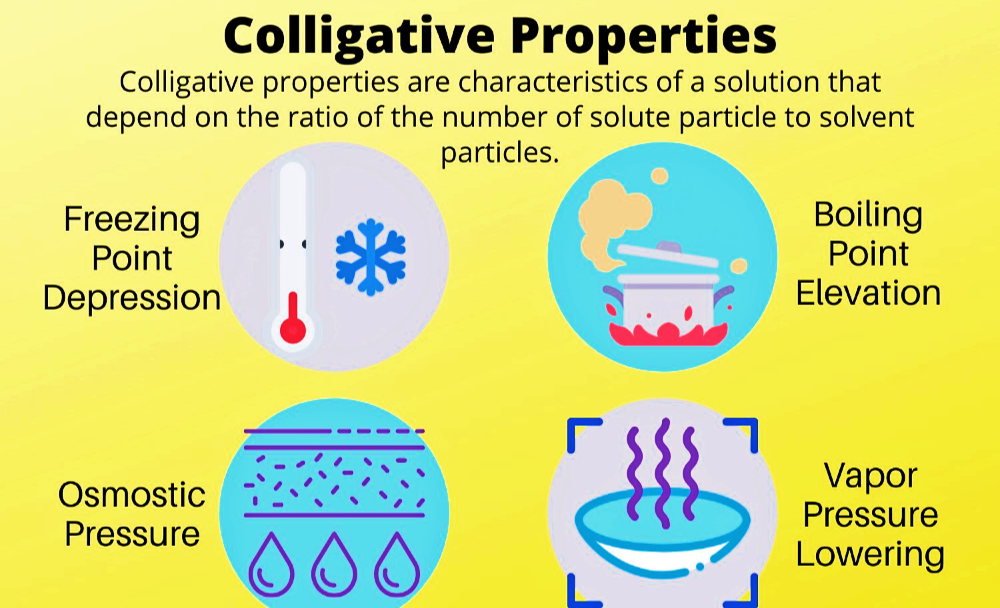Colligative Properties :-
Colligative properties are properties of solutions that depends on the ratio of the number of solute particles to the number of solvent molecules in a solution and not on the nature of the chemical species present .
- The vapour pressure of solution decreases when a non – volatile solute is added to a volatile solvent .
- There are following colligative properties of solutions which are connected with such decrease of vapour pressure .
- ( 1 ) Relative lowering of vapour pressure .
- ( 2 ) Depression of freezing point .
- ( 3 ) Elevation of boiling point .
- (4 ) Osmotic pressure.
All these colligative properties have the common characteristics that depend upon the number of Solute particles . since these properties are bound together through their common origin they are called colligative properties .
Relative lowering of Vapour Pressure :-
In a Solution containing several non – volatile solutes , the lowering of the vapour pressure depends on the sum of the mole fraction of different solutes .
P₁ = X₁ P₁⁰
Reduction of Vapour Pressure of Solvent
∆P₁ = P₁⁰ – P₁ = P₁⁰ – P₁ X₁
= P₁ ( 1 – X₁ )
Knowing that X₂ = 1 – X₁
∆P₁ = X₂ P₁⁰
The equation can be written as
∆P₁ / P₁⁰ = ( P₁⁰ – P₁ ) /P₁⁰ = X₂
This equation is called relative lowering of Vapour Pressure and is equal to the mole fraction of the Solute .
i . e . ( P₁⁰ – P₂ ) / P₁ = n₂ / n₁ + n²
since X₂ = n₂ / n₁ + n₂
Here n₁ and n₂ are the number of moles of Solvent and Solute respectively .
For dilute Solution n₂ << n₁
Then
( P₁⁰ – P₁ ) / P₁ = n₂ / n₁
Or ( P₁⁰ – P₁ ) / P₁⁰ = W₂ X M₁ / W₁ x M₂
Here W₁ and W₂ are the masses , M₁ and M₂ are the molar masses of the Solvent and Solute respectively .
Elevation of boiling point :-
The elevation of boiling point also depends on the number of Solute molecules rather than their nature .
A Solution of 1 gm of water boils at 373·52 K at one atmospheric Pressure .
Let T⁰₁ be the boiling point of pure Solvent and T₁ be the boiling point of Solution .
The increase in boiling point
∆T₁ = T₁ – T₁⁰ is known as elevation of boiling point .
- For dilute Solutions the elevation of boiling point is directly proportional to the molar concentration of the Solute in a Solution .
Thus
∆T₁ α m
∆T₁ = K₁ m
Here m is molality , K₁ is called boiling point elevation constant its SI unit is K kg mol⁻¹
- If W₂ gm of Solute of molar mass M₂ is dissolved in W₁ gm of Solvent , then molality
m = ( W₁ / M₂ ) / ( W₁ / 1000 ) = W₂ x 1000 / M₂ x W₁
Substituting the value of molality in equation
∆T₁ = K₁ m
∆T₁ = ( K₁ x W₂ x 1000 ) / M₂ x W₁
M₂ = ( K₁ x W₂ x 1000 ) / ∆T x W₁
Depression of Freezing point :-
The freezing point of a substance may be defined as the temperature at which the vapour pressure of the substance in its liquid phase is equal to its vapour pressure in the solid phase .
According to Raoult’s law when a non – volatile solid is added to the solvent become equal to that of solid solvent at lower temperature .
Thus the freezing point of the solvent decreases .
Let T⁰f be the freezing point of pure Solvent and Tf be its freexing point when non- volatile Solute is dissolved in it .
The decrease in freezing point
∆Tf = T⁰f – Tf is known as depression in freezing point .
- Depression of freezing point for dilute Solution ( Ideal Solution ) is directly proportional to molality ( m ) of the Solution
I .e . ∆Tf α m
Where Kf is known as freezing point depression constant . The unit molar depression constant is K Kg mol⁻¹ . Its value is depends on the nature of the Solvent .
- If W₂ gm of the Solute having molar mass as M₂ , present in W₁ gm of Solvent , produce depression in freezing point ∆Tf of the Solvent then molality of the Solute is given by the equation –
m = ( W₂ / M₂ ) / W₁ / 1000
or ( m = W₂ x 100 ) / M₂ x W₁
Substituting this value of molality in equation ∆Tf = Kf m
∆Tf = Kf x W₂ x 1000 / M₂ x W₁
Osmotic Pressure :-
The flow of the solvent from its side to solution side across a semipermeable membrane can stopped if some extra pressure is applied on the solution . This pressure that just stops the flow of solvent is called Osmotic pressure of the solution.
I . e . The Osmotic pressure of a solution is the the excess pressure that must be applied to a solution to prevent osmosis .
Osmosis :-
If the semipermeable membrane is placed between the solvent and solution , the solvent molecules will flow through the membrane from pure solvent to the solution . This process of flow of the solvent is called osmosis .
Semipermeable membrane :-
Semipermeable membrane is the layer that only selected molecules can pass through . It can be both biological and artificial .
Assume that only solvent molecules can pass through these membranes .
- Osmotic pressure is directly proportional to the molarity ( C ) of the solution at a given temperature ( T ).
I .e .
π = C R T
Here π is the Osmotic Pressure and R is the Gas constant .

If n₂ is moles of Solutes and V is the Volume of Solution then Osmotic Pressure
π = n₂ R T / V

Reverse Osmosis and water purification :-

The direction of osmosis can be reversed if a pressure larger than the osmotic pressure is applied to the solution side . I . e . the pure solvent flows out of the solution through the semipermeable membrane . This phenomenon is called reverse osmosis .
- Reverse osmosis is used in desalination of sea water . A schematic set up for the process in the above figure , when pressure more than osmotic pressure is applied , pure water is squeezed out of the sea water through the membrane .
- The pressure required for the reverse osmosis is quite high .








